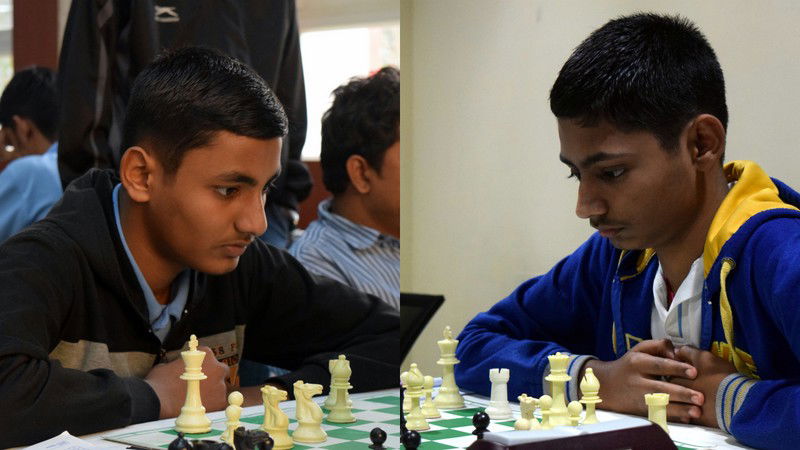Garry Kasparov in Delhi!
While you were busy doing your daily chores, Garry Kasparov walked into the Indian capital and delivered an interactive talk to entrepreneurs at the Regional Interaction Event, Zinda Dilli 2016, organised by Entrepreneurs' Organization. Garry discussed a wide range of topics like chess politics, his approach to chess, the future of the game and his invaluable insights to chess and life.

Garry Kasparov in Delhi!
On big screen, football wins. You move to this screen (smart phone) -- I am not sure you enjoy watching tennis or football, but you can watch and play chess.
Grandmaster, World Champion, author of monumental chess books, activist, politician and an ignited mind -- this is how we always knew Garry as. At the Regional Integration Event of Entrepreneurs' Organization that is being held in New Delhi, Garry threw light on various issues surrounding chess and politics that was covered in depth by the general media.
Entrepreneurs' Organization is a global peer to peer network meant exclusively for entrepreneurs. This event, titled Zinda Dilli 2016, was a networking platform for entrepreneurs from around the globe and some six-hundred enterprising minds attended the talk that was delivered by Garry Kasparov on 19th February 2016. The event will run for a couple more days with talks by such doyens as Bollywood superstar Akshay Kumar, Yoga practitioner Baba Ramdev, film Director Anurag Kashyap, business tycoon Malvinder Singh, former White House intern & controversial figure Monica Lewinsky to name a few.
Garry's interactive talk was titled 'Checkmate: Reading an Opponent’s Mind. How life imitates chess' and he delivered a memorable performance where he talked about various issues, interspersed with anecdotes and typical 'Garry humour'.

Chess and Politics
People often tend to associate politics with chess, with news channels often displaying sub-standard animations of chessboard and pieces during election-time, fittingly associating them with the various (below-par) political candidates. Kasparov promulgated to all and sundry that chess is different from politics because, in our sport, the moves are fixed!
In chess we have fixed moves and unpredictable results. In Putin's Russia, it's exactly the opposite.
Since his retirement, Kasparov has been actively participating in activism and politics, often ripping into men of Putin's stature. Donald Trump, who is 'winning hearts' in USA, has nothing to impress Garry. Trump was at the receiving end of Kasparov's criticism:
Donald Trump is a cotton candy candidate. At first sweet. But no nutrition value & makes you sick at the end!
The future of chess
Garry expressed happiness over the fact that chess is spreading rapidly across the younger generation, with an upward trend being witnessed in scholastic chess. He said he is already seeing a dramatic increase in the role chess is playing in modern society.
However, he warned that world chess does not have a competent leadership machinery at the top that can capitalise on the ever increasing popularity of the game. Garry is known to be outspoken, but he is right because had the leadership been chess-friendly, we would never see a hungry chessplayer who suffers due to the lack of funding.

What can we learn from Garry's remarks?
We often see the state, national and the world body taking all the credits for producing champion players. In a case of Stockholm-Syndrome-like behaviour, we ourselves end up giving credit to these apex bodies for producing champion players.
The reality is, the leadership comes to the fore only after the player becomes a champion. Until that point, it is always the sweat and blood of the players themselves, along with their coaches and well-wishers, that fuels the growth of chess. The controlling bodies should recognise this basic fact and start doling out credits where they are due, not by mere words but by channelising corporate and government funding to these talented chessplayers. The focus should also be on the juniors at the same time. Developing chess at the grassroots level is a sure shot way forward.
Kasparov on Indian chess
'Sky is the limit' -- that is how Kasparov summarised his opinion about chess in India. He admitted that his knowledge about the Indian chess scene is limited to what he reads, but he has noticed that India has a vibrant chess community and things will only get better.

Garry's chess philosophy
Hard Work
It annoys me when people say someone doesn't have talent, he just works hard. Hard work is also a talent!
Kasparov is considered the epitome of hard work in chess. That drive and zing to always stay a step ahead of his competitors is what made him the genius we all know him to be.
Take Risks!
He went on to say how the fear of making mistakes pulls you back. Kasparov firmly believes that one has to take risks and explore.
The way chess is played is often a reflection of society and current cultural trends. I see chess being played with machine knowledge in a risk-reducing way just the way people are conducting education and business.
Intuition and decision-making
Garry believes that the difference lies in a player's decision-making style. The first step towards designing your own decision-making process is to know who you are and create an environment of good decision-making. Insightfully, Garry added that in most cases, important decisions will be made under time pressure.
He derided the modern fad of collecting data of all sorts, only to be confused by it. It is important that we control data and not get swamped by it. In this aspect, her firmly believes in the role played by intuition in chess as well as life.
At one point you have to stop collecting data and start make decisions.
Style
There is nothing wrong if a player is overly defensive, nor in being extremely aggressive. Take cricket for example. Some batsmen attack, come what may; some stay put and defend as if their life is at stake. Sportsmen tend to have their own unique styles. One has to recognise his/her dominant qualities and strive to bring positions (on the board and off it too) that are favourable to one's innate qualities and intuition, which we must trust all the time.
Some people are naturally aggressive. Others defensive. You should use your dominant qualities to create favourable situations.
In other words, be yourself is all that you can do. And while you listen to that song, watch:
Kasparov-Topalov, Wijk aan Zee 1999
[Site "Wijk aan Zee"]
[Date "1999.01.20"]
[Round "4"]
[White "Kasparov, Garry"]
[Black "Topalov, Veselin"]
[Result "1-0"]
[ECO "B07"]
[WhiteElo "2812"]
[BlackElo "2700"]
[Annotator "Stohl,I"]
[PlyCount "87"]
[EventDate "1999.01.16"]
[EventType "tourn"]
[EventRounds "13"]
[EventCountry "NED"]
[EventCategory "17"]
[Source "ChessBase"]
[SourceDate "1999.04.01"]
prefers to spring a slight surprise on his well prepared opponent as soon as
possible.} 2. d4 Nf6 3. Nc3 ({Pirc is a somewhat rare opening in Gary's
practice and he often used to react with} 3. f3 $5 {e.g.} e5 4. d5 c6 5. c4 Qb6
6. Nc3 Be7 7. Nge2 O-O 8. Ng3 cxd5 9. Na4 $1 Qc7 10. cxd5 Bd7 11. Be3 Rc8 12.
Nc3 Na6 13. Be2 Bd8 14. O-O Qa5 15. Kh1 Nc5 16. Bd2 Ne8 17. f4 exf4 18. Bxf4
Bf6 19. Bg4 Qd8 20. Bxd7 Qxd7 21. Qf3 Rc7 22. Nf5 Bxc3 23. bxc3 Na4 24. Qg3
Nxc3 25. Rae1 f6 26. Bxd6 Nxd6 27. Nxd6 $36 {Kasparov,G-Wahls,M/GER-Kasparov/
1992/ But the Bulgarian was probably well prepared for a fight in the Saemisch,
after all he is King's Indian expert.}) 3... g6 4. Be3 Bg7 $6 {A major
exponent of the 4.Be3 line GM Vlastimil Jansa would be dissatisfied with this
move, as later Black will have to lose a tempo capturing on h6.} (4... Ng4 $6
5. Bg5 {is also not ideal, as it rather loses than gains time.}) (4... c6 $5 {
has the best reputation.} 5. h3 $1 {This useful and flexible move keeps open
both possibilities of development for White, depending on Black's reaction-f4,
or Nf3.} ({Less dangerous is} 5. Qd2 $143 Nbd7 6. Bd3 b5 7. Nf3 e5 $5 $132) {
Black's most reasonable alternative is} 5... Nbd7 (5... b5 $143 $6 6. e5 $1
dxe5 (6... Nfd7 7. exd6 exd6 8. d5 b4 9. dxc6 bxc3 10. cxd7+ Nxd7 11. b3 Be7
12. Bh6 Bb7 13. Nf3 Qa5 14. Be2 g5 15. Bg7 Rg8 16. Bd4 h5 17. Qd3 g4 18. hxg4
hxg4 19. Bxc3 Qd5 20. Qxd5 Bxd5 21. Nd4 Rc8 22. Bb4 Bxg2 23. Rg1 Ba8 24. Rxg4
Rh8 25. O-O-O $18 {Sokolov,A-Zakharevich,I/Elista/1995/}) 7. dxe5 Qxd1+ 8. Rxd1
Nfd7 9. f4 Bg7 10. Nf3 f6 11. e6 Nf8 12. Nxb5 Nxe6 13. Nxa7 Bb7 14. Bc4 Nc7 15.
Kf2 Nd5 16. Nxc6 Bxc6 17. Bxd5 Bxd5 18. Rxd5 Rxa2 19. Rb5 O-O 20. Rd1 Nc6 21.
Nd4 Nxd4 22. Bxd4 Rc8 23. Rd2 $18 {Jansa,V-Schlosser,M/Muenster/1992/}) (5...
Bg7 $143 $6 6. f4 $1 {[+]()} O-O 7. Nf3 Nbd7 8. e5 Nh5 9. Ne2 Bh8 10. g4 Ng7
11. Bg2 dxe5 12. fxe5 Nb6 13. Bh6 Be6 14. O-O Qd7 15. Nf4 Bd5 16. Nxd5 Nxd5 17.
Qe2 Rad8 18. Rae1 Nc7 19. c3 Nce6 20. Nd2 Qc7 21. Ne4 a5 22. Rf2 b5 23. Ref1
Qb6 24. Kh1 $40 {Jansa,V-Hoi,C/Gausdal/1991/}) 6. f4 e5 7. Qf3 $5 {This
position is still quite rare in practice.} {Black's main problem is to break
up effectively the strong pawn cahin e4,f5, so deserving attention is} b5 $142
$5 (7... Qa5 8. Bd3 Bg7 9. dxe5 dxe5 10. f5 b5 (10... gxf5 $6 11. Qxf5 $1 b5
12. Nge2 b4 13. Nb1 Nb6 14. Qf2 Na4 15. O-O Be6 16. b3 Nb2 17. Ng3 Nxd3 18.
cxd3 Qb5 19. Nd2 Rd8 20. Bg5 $40 {Movsesian,S-Ftacnik,L/Hamburg op/1997/}) 11.
Nge2 $36 (11. g4 $143 $6 b4 12. Nd1 gxf5 $1 13. gxf5 b3+ 14. Nc3 bxc2 15. Nge2
Rb8 16. Bc1 Rg8 17. Bxc2 Bf8 18. b3 Ba6 19. Bd2 Bb4 20. a3 Nh5 21. Qxh5 Bxe2
22. Nxe2 Bxd2+ $17 {Kharlov,A-Labok,V/Podolsk/1992/})) 8. O-O-O (8. Bd3 Bb7
$132) 8... b4 9. Nce2 Qe7 10. dxe5 dxe5 11. f5 gxf5 12. Qxf5 (12. exf5 $6 Bb7
13. g4 Nd5 14. Bf2 e4 15. Qg3 e3 16. Be1 Bg7 17. g5 Be5 18. Qg4 h5 19. Qg2
O-O-O 20. Nf3 Nf4 21. Nxf4 Bxf4 22. Be2 c5 23. h4 Ne5 24. Rxd8+ Rxd8 25. Kb1
Nxf3 {0-1,Wagener,C-Andersen,J/Szeged/1994/}) 12... Qe6 $5 $13 {<=>}) 5. Qd2 c6
6. f3 {More consistent and preferred by Jansa is} (6. Bh6 $5 {as White can
sometimes effectively play f4 later on.} Bxh6 7. Qxh6 Qa5 (7... b5 8. e5 $1 b4
9. exf6 bxc3 10. bxc3 exf6 11. Bd3 Qe7+ 12. Ne2 Qf8 13. Qd2 Qe7 14. O-O O-O 15.
Rfe1 f5 16. c4 Nd7 17. Rab1 Nb6 18. Qa5 Be6 19. Nf4 Qf6 20. c5 dxc5 21. Nxe6
fxe6 22. Qxc5 $16 {Jansa,V-Gazik,I/CSR-chT/1992/}) 8. Bd3 c5 $5 (8... b5 9. Nf3
b4 10. Ne2 Ba6 11. O-O Nbd7 12. Ng3 Bxd3 13. cxd3 Rg8 14. Qd2 Rb8 15. a3 Qb5
16. axb4 Qxb4 17. Qxb4 Rxb4 18. Rfc1 Nb8 19. Rxa7 Rxb2 20. e5 $1 $36 {עe8,Van
der Wiel,J-Azmaiparashvili,Z/Wijk aan Zee/1993/}) ({Rather passive is} 8...
Nbd7 9. Nf3 e5 10. O-O exd4 11. Nxd4 Qh5 12. Qd2 O-O 13. Be2 Qe5 14. f4 Qe7 15.
Bf3 Nb6 16. Rae1 Rd8 17. b3 c5 18. Nde2 Bd7 19. Ng3 Bc6 20. a4 $16 {(),[+]
Adams,M-Nogueiras,J/Buenos Aires/1991/}) 9. Nge2 (9. Nf3 $143 Bg4 $1 $13) 9...
cxd4 10. Nxd4 Nc6 $5 ({Unplayable is} 10... Qb6 $2 11. O-O-O Nc6 12. Nxc6 bxc6
13. e5 $1 dxe5 14. Ne4 Be6 15. Qg7 O-O-O 16. Nxf6 exf6 17. Qxf6 Rhe8 18. Rhe1
Bg4 19. f3 e4 20. Rxe4 Rxe4 21. Ba6+ Qxa6 22. Rxd8+ Kb7 23. Qxf7+ Kb6 24. fxe4
{1-0,Jansa,V-Hoffmann,H/BL2-O 9697/1997/}) 11. Nb3 Qb6 12. Nd5 (12. O-O-O Be6
13. f3 O-O-O 14. Rhe1 Kb8 15. Bf1 Rc8 16. Qe3 Qxe3+ 17. Rxe3 g5 18. g3 h5 19.
f4 h4 20. Bb5 Ng4 21. Re2 hxg3 22. hxg3 Rh3 $15 {Kroeze,F-Beim,V/Leeuwarden/
1994/}) 12... Nxd5 13. exd5 Nb4 $5 $132 (13... Ne5 14. O-O Bd7 15. Be2 O-O-O
16. a4 Kb8 17. a5 Qc7 18. c4 Bg4 19. Bxg4 Nxg4 20. Qf4 Ne5 21. Ra4 g5 22. Qd4
h5 23. Rc1 h4 24. Qe3 h3 25. g3 e6 26. Nd4 Qc5 27. Rc3 Ng4 28. Qd2 e5 29. Nb3
Qc8 30. c5 $40 {Hamdouchi,H-Chabanon,J/FRA-chT/1998/})) 6... b5 7. Nge2 {
White has various possibilities here.} ({Not too promising is the old line} 7.
O-O-O Qa5 8. Kb1 Nbd7 9. Bh6 Bxh6 10. Qxh6 Nb6 11. Nh3 Bxh3 $1 12. Qxh3 Na4 $1
$15) ({Ultra-sharp is} 7. g4 h5 $5 (7... Nbd7) 8. g5 Nfd7 9. f4 Nb6 $13) 7...
Nbd7 8. Bh6 Bxh6 9. Qxh6 Bb7 {Black should strive for immediate counterplay.} (
9... e5 $142 $5 10. a3 {and forcing a central exchange costs Black precious
time, e.g.} ({Too soft is} 10. dxe5 $143 $6 dxe5 11. Nc1 Bb7 12. Nd3 Qe7 13. g3
O-O-O 14. b4 a5 15. a3 Kc7 16. Be2 axb4 17. axb4 Ra8 $11 {Kristensen,B-Hansen,
C/Vejle/1994/}) 10... Qa5 11. dxe5 dxe5 12. Nc1 Bb7 13. b4 $1 Qb6 14. Nb3 $14)
(9... Qa5 10. Nc1 b4 (10... Qb6 11. Nb3 a5 12. a4 b4 13. Nd1 Ba6 14. Ne3 Bxf1
15. Rxf1 Qa6 (15... c5 $5 16. Nc4 Qa6 17. Nbxa5 cxd4 18. Qd2 $14) 16. Kf2 Rc8
17. Kg1 c5 18. dxc5 Nxc5 19. Nd4 Qb6 20. Nc4 Qa6 21. b3 Ncd7 22. Nb5 Ne5 23.
Ne3 Qb6 24. Kh1 Rc5 25. Rad1 Rg8 26. Rd2 g5 27. Nxd6+ Qxd6 28. Rxd6 Rg6 29.
Rxf6 {1-0,Moroz-Janda/Decin/1998/}) 11. Nb3 Qh5 12. Qxh5 Nxh5 13. Nd1 a5 14. a3
Bb7 15. axb4 axb4 16. Rxa8+ Bxa8 17. Nf2 O-O 18. Nd3 c5 19. dxc5 dxc5 20. Nbxc5
Nxc5 21. Nxc5 Rc8 22. Nd3 Rxc2 23. Kd1 b3 24. Be2 Bb7 25. Re1 f5 26. exf5 gxf5
27. Nb4 $1 $14 {Rantanen,Y-Jamieson,R/Haifa olm/1976/}) 10. a3 $1 {The right
moment for prophylaxis} (10. O-O-O $143 $6 Qa5 $36) ({Gary tries to achieve a
better version of} 10. Nc1 e5 11. dxe5 dxe5 12. Nb3 a6 13. O-O-O Qc7 $5 14. Qg7
Rf8 (14... Rg8 $2 15. Rxd7 $18) 15. g3 O-O-O 16. Bh3 Kb8 17. Bxd7 Nxd7 18. Qxh7
a5 19. Kb1 a4 20. Nc1 a3 21. b3 b4 22. N3e2 c5 23. Qh6 f5 $5 $44 {Moroz,
A-Yurasov,A/Simferopol/1991/}) 10... e5 (10... a5 11. Nd1 b4 12. Ng3 $5 $14 {
As Black's K will have to castle <<, he doesn't want to weaken his position
here any further.}) 11. O-O-O Qe7 {Black wants to get his K to safety as soon
as possible.} ({But interesting was} 11... a6 $5 12. Kb1 (12. f4 Ng4 13. Qg7
Qf6 $11 {nikam nevedie a po}) 12... Qc7 {/\ (Covers a5.)} 13. dxe5 dxe5 14. Qg7
Ke7 $5 $132) 12. Kb1 a6 13. Nc1 $1 O-O-O 14. Nb3 exd4 $5 {Topalov realizes the
danger, connected with Na5 followed by a timely d5-> and decides to open up
the position and fight.} (14... c5 $6 15. d5 $16) 15. Rxd4 (15. Nxd4 c5 16. Nb3
{-15.Rd4}) 15... c5 16. Rd1 Nb6 {/\d5} (16... Ne5 17. Be2 d5 $2 18. f4 {/\e5+/-
}) 17. g3 {'!' Ftacnik.} Kb8 (17... d5 $5 18. Bh3+ (18. Qf4 d4 19. Bh3+ Nfd7
$13) 18... Kb8 19. exd5 (19. Qf4+ Ka7 $1 {/\} 20. Nxc5 $2 Nh5 21. Qe3 d4 $1 $17
) 19... Nbxd5 20. Nxd5 Nxd5 (20... Rxd5 21. Qf4+ $5 Qe5 22. Qxe5+ Rxe5 23. Rd6
$36) 21. Na5 $14) 18. Na5 $6 {Kasparov already envisages the rich
combinational possibilities, but this very natural move is probably
objectively not the best.} (18. Bh3 $142 $5 {/\Rhe1} d5 19. exd5 {-17...d5!?})
({Deserving attention is also} 18. Qf4 Ka7 (18... Ka8 19. Na5 $36) 19. g4 $5 {
/\Bb5 and Black can't play} (19. Bxb5 Nh5 20. Qh4 $5 Qxh4 21. gxh4 axb5 22.
Nxb5+ Kb8 23. Nxd6 f5 24. Nxc5 Bd5 $5 $13) 19... d5 $2 20. Nxc5 $1 $16) 18...
Ba8 19. Bh3 d5 20. Qf4+ Ka7 21. Rhe1 d4 {Ftacnik: 'Black has achieved
impressive success, but his position is a bit dangerous. Kasparov unleashes
phantastic combination.'} ({Opening the position is suicide, after} 21... dxe4
22. fxe4 {/\Nd5} Nxe4 (22... Rxd1+ 23. Rxd1 Nxe4 24. Rd7+ $1 $18) 23. Nxe4
Rxd1+ 24. Rxd1 Bxe4 25. Re1 Re8 26. Rxe4 $1 Qxe4 27. Qc7+ Ka8 28. Nc6 $18) 22.
Nd5 {'!' Ftacnik.} Nbxd5 (22... Nfxd5 $2 23. exd5 Qd6 24. Qxf7+ $18) 23. exd5
Qd6 24. Rxd4 $1 {'!!' Ftacnik.} (24. Qxd6 $2 Rxd6 25. b4 cxb4 26. axb4 Nxd5 $17
) (24. Nc6+ Bxc6 25. dxc6 Qxf4 26. Re7+ (26. gxf4 Nd5 $5 $15) 26... Kb6 27.
gxf4 Nd5 28. Rxf7 Rdf8 $15) 24... cxd4 $2 {Ftacnik: 'It should be noted, that
24...Kb6! would most certainly save the game for black, but we would be robbed
of some fascinating lines. '} (24... Kb6 $142 $1 $11) (24... Bxd5 $5 25. Rxd5
$1 Nxd5 (25... Qxf4 26. Rxd8 Qh6 (26... Qc7 27. Rxh8 Qxa5 28. Re7+ $18) 27.
Re7+ Kb6 28. b4 $1 $18) 26. Qxf7+ Nc7 27. Re6 Rd7 (27... Qd1+ 28. Ka2 Rd7 29.
Re7 $16) 28. Rxd6 Rxf7 29. Nc6+ Ka8 30. f4 $44) 25. Re7+ $3 {'!' Ftacnik. The
real point of the combination.} (25. Qxd4+ $2 Qb6 $1 26. Re7+ Nd7 27. Rxd7+ (
27. Qc3 Qg1+) 27... Rxd7 28. Qxh8 Rxd5 $19) 25... Kb6 (25... Qxe7 $2 26. Qxd4+
$18) (25... Kb8 26. Qxd4 Nd7 27. Bxd7 Bxd5 28. c4 $1 $18) 26. Qxd4+ Kxa5 (26...
Qc5 27. Qxf6+ Qd6 28. Be6 $3 Bxd5 29. b4 $18) 27. b4+ Ka4 28. Qc3 $5 {This
shows Kasparov's combination was more intuitive, than arithmetically exact.
Ftacnik: 'It seems, that white could have won more easily with the help of a
fine move 28.Ra7!!'} ({A simpler and even more beautiful win was found by (I
think) Kavalek:} 28. Ra7 $1 {/\} Bb7 (28... Nxd5 {Ftacnik} 29. Rxa6+ $3 Qxa6
30. Qb2 Nc3+ 31. Qxc3 Bd5 32. Kb2 Qe6 33. Bxe6 fxe6 34. Qb3+ $1 Bxb3 35. cxb3#)
29. Rxb7 Qxd5 (29... Nxd5 30. Bd7 $3 Ra8 (30... Rxd7 31. Qb2 Nc3+ 32. Qxc3 Qd1+
33. Kb2 Rd3 34. Ra7 $1 $18) 31. Bxb5+ axb5 32. Ra7+ Qa6 33. Qxd5 Qxa7 34. Qb3#)
30. Rb6 $1 $18 (30. Rb6 Ra8 (30... a5 31. Ra6 Ra8 32. Qe3 $3 Rxa6 (32... Rhe8
33. Rxa8 Rxa8 34. Kb2 $18) 33. Kb2 axb4 34. axb4 Kxb4 35. Qc3+ Ka4 36. Qa3#)
31. Qxf6 a5 32. Bf1 $18)) 28... Qxd5 (28... Bxd5 $2 29. Kb2) 29. Ra7 (29. Kb2
$2 Qd4) 29... Bb7 $8 30. Rxb7 (30. Qc7 $2 Qd1+ $11) 30... Qc4 $6 {Ftacnik:
'Black is spoiling the defensive effort, it was much tougher to win the game
after the best 30...Rhe8!'} ({A better chance was} 30... Rhe8 $1 31. Rb6 (31.
Ra7 $2 Rd6 32. Kb2 Qe5 $19) 31... Ra8 32. Bf1 $3 $18 {/\Rd6} (32. Be6 $143 Rxe6
33. Rxe6 Qc4 $1 34. Qxc4 bxc4 35. Rxf6 Kxa3 36. Rxf7 Re8 $11)) 31. Qxf6 Kxa3 {
Now White wins by force.} (31... Rd1+ $142 32. Kb2 Ra8 (32... Qd4+ 33. Qxd4
Rxd4 34. Rxf7 Rd6 35. Re7 {/\Be6}) 33. Qb6 Qd4+ (33... a5 34. Bd7 $1 Rd5 35.
Qe3 axb4 36. Ra7+ $18) 34. Qxd4 Rxd4 35. Rxf7 a5 36. Be6 axb4 37. Bb3+ Ka5 38.
axb4+ Rxb4 (38... Kb6 39. Rxh7 {and with 3 pawns for the exchange White
gradually wins.}) 39. c3 $16 {_|_R}) (31... Ra8 $2 32. Qb6 a5 33. Ra7 $18) 32.
Qxa6+ Kxb4 33. c3+ $1 Kxc3 (33... Kb3 34. Qa2+ Kxc3 35. Qb2+ Kd3 36. Re7 $1 $18
) 34. Qa1+ Kd2 $8 (34... Kb4 35. Qb2+ Ka5 (35... Qb3 36. Rxb5+) 36. Qa3+ Qa4
37. Ra7+ $18) 35. Qb2+ Kd1 {Ftacnik: 'You are not dreaming, black king went
all the way from e8 to d1!'} (35... Ke3 $2 36. Re7+) (35... Ke1 36. Re7+ Kd1
37. Bf1 $1 $18 {is the same as in the game.}) 36. Bf1 $1 Rd2 $8 37. Rd7 $1 {
Ftacnik: 'The final trick, but white is completely right, the game is finally
over.'} Rxd7 38. Bxc4 bxc4 $8 39. Qxh8 Rd3 (39... Rb7+ 40. Ka2 Kc2 41. Qd4 $18)
40. Qa8 c3 41. Qa4+ Ke1 (41... Kd2 42. Qc2+) 42. f4 f5 43. Kc1 Rd2 44. Qa7 1-0
Links to the media coverage on Kasparov's visit:
The Hindu: Role of chess in modern society has increased: Kasparov
PTI: Garry Kasparov speaks to entrepreneurs at RIE 2016
Business Line: Intuition plays a big part in making the right move: Kasparov

